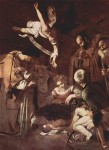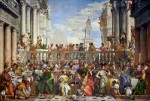 On the night of the 17th or early morning of the 18th of October, 1969, one or two men broke into the Oratory of San Lorenzo in Palermo, Sicily, and stole the Nativity with St. Francis and St. Lawrence by Baroque master Michelangelo Merisi, better known as Caravaggio. They cut the monumental painting (9.7 by 6.5 feet) out of the frame and made off with it into the night. It was never seen again.
On the night of the 17th or early morning of the 18th of October, 1969, one or two men broke into the Oratory of San Lorenzo in Palermo, Sicily, and stole the Nativity with St. Francis and St. Lawrence by Baroque master Michelangelo Merisi, better known as Caravaggio. They cut the monumental painting (9.7 by 6.5 feet) out of the frame and made off with it into the night. It was never seen again.
Over the years various stories have emerged attending its fate, none of them good. Mafia turncoats have proffered up a profusion of tales. One claimed it was hanging in the secret location where the Cosa Nostra leaders, known as the Commissione or Cupola, meet to make decisions and adjudicate disputes. Another testified in the 1996 trial of former prime minister Giulio Andreotti (who was accused of being mob connected) that he was one of the thieves who stole the Nativity on commission. He and his colleague had done such a bad job of cutting out and roughly folding the painting that the man who commissioned the theft wept when he saw the work and refused to accept it.
Another witness said the painting had been stolen by local amateurs who had seen a TV show about it and knew it was basically unguarded. They got in trouble with the Mafia for pulling such a heist on their turf without permission, so they had to hand it over. It then passed through the hands of a couple of other Mafiosi before ending up with murderer and heroin trafficker Gerlando Alberti who tried to sell it for a dozen years without success. When he was about to be arrested for yet another murder, he rolled the painting in a rug and put it in an iron chest with five kilos of heroin and several million dollars. When the cops went to the location where the chest had ostensibly been buried, it was gone.
Most recently in 2009 former hitman Gaspare Spatuzza testified that his boss had told him the Nativity was given to the Pullara family for safekeeping. They hid it in a farm outbuilding where it was eaten by rats and pigs and the remnants were burned.
 As all these stories proliferate but lead nowhere, the small chapel adorned with white stucco sculptures in the Oratory of San Lorenzo where Caravaggio’s Nativity once towered over the altar was left bereft. A four-by-five inch color photograph taken by Enzo Brai in 1968 was blown up and inserted into the frame, but even a nice picture by a professional photographer can’t even begin to convey the greatness of the original when blown up to such a large size.
As all these stories proliferate but lead nowhere, the small chapel adorned with white stucco sculptures in the Oratory of San Lorenzo where Caravaggio’s Nativity once towered over the altar was left bereft. A four-by-five inch color photograph taken by Enzo Brai in 1968 was blown up and inserted into the frame, but even a nice picture by a professional photographer can’t even begin to convey the greatness of the original when blown up to such a large size.
In December of 2014, Factum Arte got involved. The Madrid-based company is an innovator in using digital technology to create high quality reproductions of art. They made the exact 3D replica of King Tut’s tomb which opened last year at the Valley of the Kings, and that exceptional virtual tour through Piranesi’s fantasy prisons.
 Factum Arte also made a frankly mind-boggling facsimile of Veronese’s gigantic 22-by-33-foot Wedding at Cana for the Palladio Refectory on the island of San Giorgio Maggiore in Venice. The original was made specifically for that space and hung there for 235 years before it was looted by Napoleon’s troops. It is now in the Louvre and they ain’t coughing it up any time soon, so in 2006 they agreed to let Factum Arte scan the original to make an accurate facsimile for the Refectory. It was a smashing success.
Factum Arte also made a frankly mind-boggling facsimile of Veronese’s gigantic 22-by-33-foot Wedding at Cana for the Palladio Refectory on the island of San Giorgio Maggiore in Venice. The original was made specifically for that space and hung there for 235 years before it was looted by Napoleon’s troops. It is now in the Louvre and they ain’t coughing it up any time soon, so in 2006 they agreed to let Factum Arte scan the original to make an accurate facsimile for the Refectory. It was a smashing success.
The quality and beauty of the Cana facsimile sparked the idea of creating a better stand-in for the missing Nativity. Early this year Factum Arte began creating a rematerialization of the Caravaggio’s painting using Brai’s photograph and some very detailed black-and-white glass-plate negatives taken by conservators who worked on the Nativity in 1951. To say it was a complicated process is a significant understatement.
The experts used sophisticated, 52 mega-pixel cameras and purpose-built digital printers to make copies of the images, steadily building them up into a composite image that was as faithful to Caravaggio’s original canvas as technically possible. They painted in details in a style that was true to Caravaggio’s famous “chiaroscuro” technique of depicting light and shade. They were even able to replicate the original brushstrokes left by the Renaissance painter.
“We worked by hand to decipher and interpret areas where the photographic information was not sufficient,” said [artist Adam] Lowe, who did the painting along with a colleague.
“It was a constant process, moving between the digital realm and the physical realm. We created multiple layers to build up the densities of tone and colour. We took photographs about the size of a postcard and then stitched them together digitally,” said Mr Lowe, who founded Factum Arte, a multidisciplinary workshop aimed at art conservation, in 2000.
 Factum Arte was fortunate to have precious data on Caravaggio’s brushstrokes and pigments. In September and October of 2009, they took detailed high resolution photographs of the three Caravaggio paintings in the church of San Luigi dei Francesi in Rome to make facsimiles for the artist’s hometown of Caravaggio. For more details about how they made the magic happen, read this pdf from Factum Arte’s website.
Factum Arte was fortunate to have precious data on Caravaggio’s brushstrokes and pigments. In September and October of 2009, they took detailed high resolution photographs of the three Caravaggio paintings in the church of San Luigi dei Francesi in Rome to make facsimiles for the artist’s hometown of Caravaggio. For more details about how they made the magic happen, read this pdf from Factum Arte’s website.
They printed the finished file as an ultra high resolution digital print on canvas prepped with gesso. Once in Palermo, the painting was stretched and hung in the frame that once held the original. It was unveiled Saturday with much fanfare and emotion for the return in any form of one of Palermo’s most beloved treasures. The President of Italy, Palermo native Sergio Mattarella, presided over the ceremonies.
The work is funded by Sky Arte TV and Ballandi Multimedia who have made a documentary about the theft and the creation of the facsimile which is set to debut in January in Europe. No word on streaming services or US distribution.
Wow, what a business idea. Something tells me we haven’t heard the last of Factum Arte on this site.
Thanks for telling this story – it’s a good one and the reconstruction looks good.
Very interesting. I agree we will not have heard the last of Factum Arte.
One thing I would like to add though: You mentioned the 1968 photograph taken by Brai. You described it as a “4 by 5 inch photograph” but considering the fact that it was taken by a professional photographer and of sufficient quality to be enlarged to such a scale, I am sure it must have been a 4 by 5 inch negative (actually, amateur colour film from the 1960’s was often of low quality chemically and usually turns out to have lost much of its colour by now. That is why family snaps from that time have often turned kind of orange). Those were used a lot by professional photographers at the time (and by still photographers and architecture photographers until fairly recently). The negatives are single 4 by 5 inch sheets which are loaded in cartridges which can be inserted at the back of a view camera. This type of camera allows the photographer to adjust the perspective and the field of focus, making it ideal to photograph something like a big painting hanging high up on a wall.
https://en.wikipedia.org/wiki/View_camera
A process like this sounds like ancient history now but I was still trained to use these cameras when I was in art school in the early 2000’s (by the time I graduated, they had changed the curriculum though. I think I may have been the last student to use this a lot)
Hi – I wondered where the great photo of the chapel with the empty frame (second image down) is from? Could you possibly email me to let me know?
Many thanks
Sara